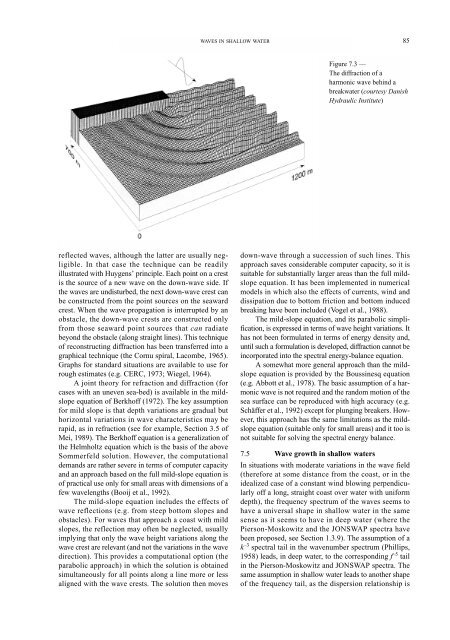GUIDE WAVE ANALYSIS AND FORECASTING - WMO
GUIDE WAVE ANALYSIS AND FORECASTING - WMO
GUIDE WAVE ANALYSIS AND FORECASTING - WMO
You also want an ePaper? Increase the reach of your titles
YUMPU automatically turns print PDFs into web optimized ePapers that Google loves.
eflected waves, although the latter are usually negligible.<br />
In that case the technique can be readily<br />
illustrated with Huygens’ principle. Each point on a crest<br />
is the source of a new wave on the down-wave side. If<br />
the waves are undisturbed, the next down-wave crest can<br />
be constructed from the point sources on the seaward<br />
crest. When the wave propagation is interrupted by an<br />
obstacle, the down-wave crests are constructed only<br />
from those seaward point sources that can radiate<br />
beyond the obstacle (along straight lines). This technique<br />
of reconstructing diffraction has been transferred into a<br />
graphical technique (the Cornu spiral, Lacombe, 1965).<br />
Graphs for standard situations are available to use for<br />
rough estimates (e.g. CERC, 1973; Wiegel, 1964).<br />
A joint theory for refraction and diffraction (for<br />
cases with an uneven sea-bed) is available in the mildslope<br />
equation of Berkhoff (1972). The key assumption<br />
for mild slope is that depth variations are gradual but<br />
horizontal variations in wave characteristics may be<br />
rapid, as in refraction (see for example, Section 3.5 of<br />
Mei, 1989). The Berkhoff equation is a generalization of<br />
the Helmholtz equation which is the basis of the above<br />
Sommerfeld solution. However, the computational<br />
demands are rather severe in terms of computer capacity<br />
and an approach based on the full mild-slope equation is<br />
of practical use only for small areas with dimensions of a<br />
few wavelengths (Booij et al., 1992).<br />
The mild-slope equation includes the effects of<br />
wave reflections (e.g. from steep bottom slopes and<br />
obstacles). For waves that approach a coast with mild<br />
slopes, the reflection may often be neglected, usually<br />
implying that only the wave height variations along the<br />
wave crest are relevant (and not the variations in the wave<br />
direction). This provides a computational option (the<br />
parabolic approach) in which the solution is obtained<br />
simultaneously for all points along a line more or less<br />
aligned with the wave crests. The solution then moves<br />
<strong>WAVE</strong>S IN SHALLOW WATER 85<br />
Figure 7.3 —<br />
The diffraction of a<br />
harmonic wave behind a<br />
breakwater (courtesy Danish<br />
Hydraulic Institute)<br />
down-wave through a succession of such lines. This<br />
approach saves considerable computer capacity, so it is<br />
suitable for substantially larger areas than the full mildslope<br />
equation. It has been implemented in numerical<br />
models in which also the effects of currents, wind and<br />
dissipation due to bottom friction and bottom induced<br />
breaking have been included (Vogel et al., 1988).<br />
The mild-slope equation, and its parabolic simplification,<br />
is expressed in terms of wave height variations. It<br />
has not been formulated in terms of energy density and,<br />
until such a formulation is developed, diffraction cannot be<br />
incorporated into the spectral energy-balance equation.<br />
A somewhat more general approach than the mildslope<br />
equation is provided by the Boussinesq equation<br />
(e.g. Abbott et al., 1978). The basic assumption of a harmonic<br />
wave is not required and the random motion of the<br />
sea surface can be reproduced with high accuracy (e.g.<br />
Schäffer et al., 1992) except for plunging breakers. However,<br />
this approach has the same limitations as the mildslope<br />
equation (suitable only for small areas) and it too is<br />
not suitable for solving the spectral energy balance.<br />
7.5 Wave growth in shallow waters<br />
In situations with moderate variations in the wave field<br />
(therefore at some distance from the coast, or in the<br />
idealized case of a constant wind blowing perpendicularly<br />
off a long, straight coast over water with uniform<br />
depth), the frequency spectrum of the waves seems to<br />
have a universal shape in shallow water in the same<br />
sense as it seems to have in deep water (where the<br />
Pierson-Moskowitz and the JONSWAP spectra have<br />
been proposed, see Section 1.3.9). The assumption of a<br />
k –3 spectral tail in the wavenumber spectrum (Phillips,<br />
1958) leads, in deep water, to the corresponding f –5 tail<br />
in the Pierson-Moskowitz and JONSWAP spectra. The<br />
same assumption in shallow water leads to another shape<br />
of the frequency tail, as the dispersion relationship is

















